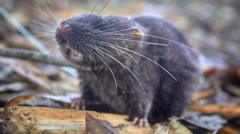In an exciting expedition to Peru’s Alto Mayo, scientists have unveiled 27 newly discovered species, including a unique swimming mouse with webbed feet and a curious blob-headed fish. This initiative led by Conservation International, alongside local indigenous groups, sheds light on the biodiversity nestled within the Amazon rainforest region.
Trond Larsen, a senior director at Conservation International, expressed amazement at finding so many mammals and vertebrates in such a human-driven landscape. The expedition also hinted at the potential discovery of up to 48 additional species awaiting confirmation.
Alto Mayo, protected from excessive human encroachment, is home to diverse ecosystems and Indigenous territories, emphasizing the ongoing struggle against deforestation and agricultural expansion. An Awajún woman involved in the research, Yulisa Tuwi, explained how these findings help her community protect their culture and natural resources by enhancing their understanding of local ecosystems.
Among the discoveries were eight varieties of fish, three types of amphibians, a new genus of dwarf squirrel measuring just 14cm, and 10 species of butterflies. One surprising find was a spiny mouse, known for its distinct stiff guard hairs, resembling a hedgehog’s spines. The expedition also confirmed a rare amphibious mouse, one of the world’s few semi-aquatic rodents, and a climbing salamander, adding to the rich tapestry of biodiversity in the region.
In this blend of science and indigenous knowledge, the expedition proves that there’s still much to learn about our planet’s natural wonders!
Trond Larsen, a senior director at Conservation International, expressed amazement at finding so many mammals and vertebrates in such a human-driven landscape. The expedition also hinted at the potential discovery of up to 48 additional species awaiting confirmation.
Alto Mayo, protected from excessive human encroachment, is home to diverse ecosystems and Indigenous territories, emphasizing the ongoing struggle against deforestation and agricultural expansion. An Awajún woman involved in the research, Yulisa Tuwi, explained how these findings help her community protect their culture and natural resources by enhancing their understanding of local ecosystems.
Among the discoveries were eight varieties of fish, three types of amphibians, a new genus of dwarf squirrel measuring just 14cm, and 10 species of butterflies. One surprising find was a spiny mouse, known for its distinct stiff guard hairs, resembling a hedgehog’s spines. The expedition also confirmed a rare amphibious mouse, one of the world’s few semi-aquatic rodents, and a climbing salamander, adding to the rich tapestry of biodiversity in the region.
In this blend of science and indigenous knowledge, the expedition proves that there’s still much to learn about our planet’s natural wonders!


















